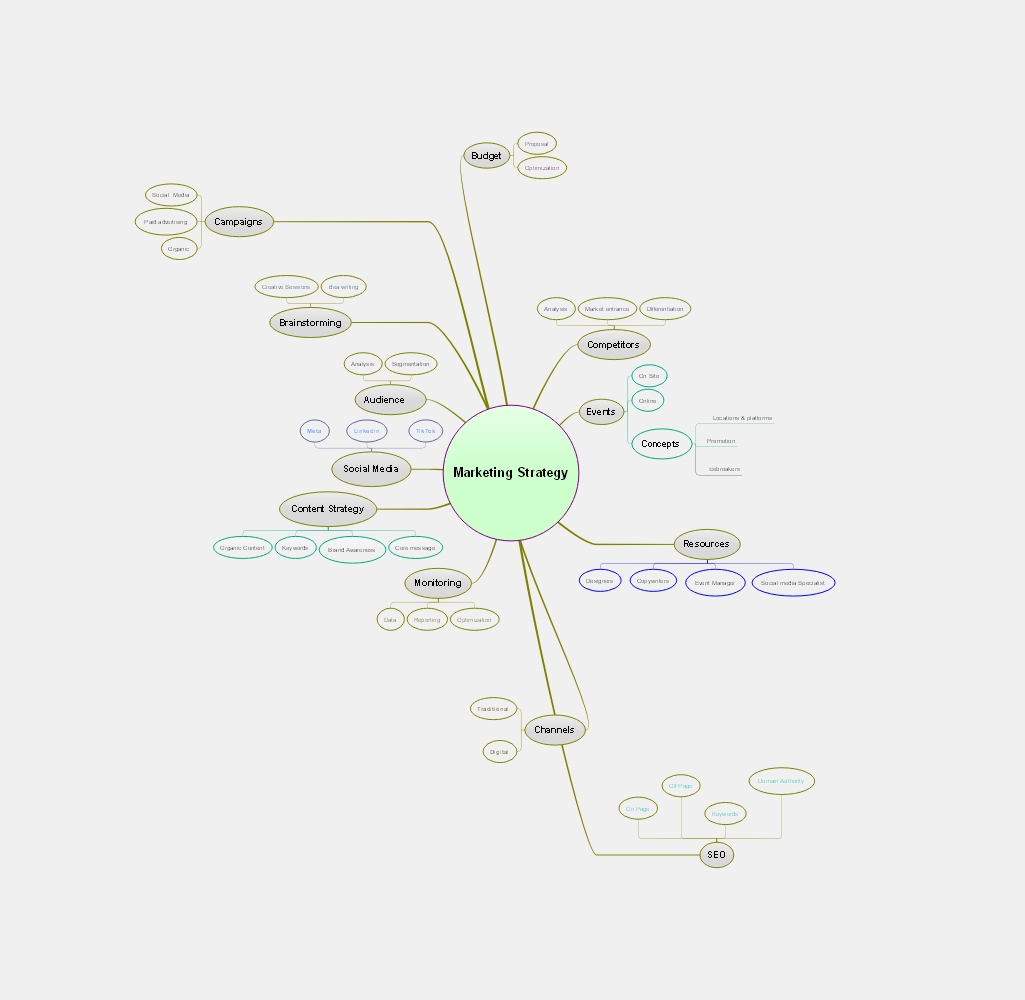Many organizations are increasingly adopting strategic marketing methodologies due to their potential to gain a competitive edge. However, sometimes there remains a lack of clear understanding regarding the essence of strategic marketing. Strategic marketing presents a thorough assessment of an organization’s strengths related to its competitors from the perspective of its target customer base. The strategic marketing process involves researching and setting goals to maximize the effectiveness of the marketing strategy, meaning attracting customers and driving revenue to the organization. By leveraging it, organizations can enhance their service or product offerings and value propositions to customers, while also crafting a unique brand image on the market.
Effectively integrating strategic marketing into a business strategy requires addressing three fundamental questions:
- How does the organization perceive its strengths and potential advantages in relation to competitors?
- What are the perceptions of the target consumer base regarding the organization and its competitors?
- How can the organization utilize these insights to deliver superior value and differentiate itself effectively in the market?
Since many questions are coming along the way to complete all the above mentioned and properly set the marketing strategy, its plan and execution, they can empower marketing teams to get the answers to the questions above.
But how can mind maps be used as a tool for strategic planning?
Mind maps serve as highly dynamic and versatile tools that provide marketers to elevate their strategic thinking, enhance collaboration skills, stimulate creativity, and visualize the ideas and efforts generated by the team and involved stakeholders. Regardless of the specific requirements of any marketing team, mind maps offer an excellent method to plan and organize various aspects of their work. Starting from throwing ideas for building a creative concept, to planning, launching campaigns, cross-collaborating on different projects, analyzing, setting up integrated plan etc.
The Role of Mind Maps in Strategic Marketing
In everyday operations within an organization, marketing helps companies to attract customers for their business, so it is essential to know how to attract them, who these people are, what are their habits, how they consume content, how to interact with them, what are their needs and who you want to attract first. Therefore, proper identification of the target audience is crucial for effective marketing strategies to succeed. Strategic marketing serves as the channel for obtaining this crucial information.
This process is helpful because it sets a strong core base for the marketing team that they target the right audience, have selected the right markets and use the right communication channels. Simply put, strategic marketing helps marketing teams and companies to uncover the information to create effective marketing plans and execute successful campaigns. Even though it sounds like it is simple and straight forward process, it can be quite challenging. Combining creative ideas and data sources to get to the right customers at the right time with the right offer can be a not so smooth path to walk. Therefore, putting all the information in one place, organizing, structuring, and combining it can get any team to find the right formula for success.
Mind maps can be incredibly effective tools for streamlining strategic planning processes in several ways. From visualization, organizational structure, brainstorming and idea generation and setting up the planning process mind maps can facilitate and streamline the planning process in strategic marketing for the whole team.
- Visualization: Mind maps offer a visual representation of ideas, concepts, and their interconnections, helping teams in better understanding complex information and seeing the big picture of their strategic plan.
- Organizational structure: Mind maps facilitate the organization of ideas into a hierarchical structure, where primary branches represent major goals or objectives, and sub-branches represent strategies, tactics, or actionable items. This systematic setting helps teams in breaking down their strategic plan into manageable segments.
- Brainstorming and idea generation: When many ideas are thrown around and not written, it is expected that something will be forgotten or not implemented, but most commonly those ideas would have the greatest impact. Therefore, a mind map is an excellent tool for brainstorming sessions. It allows teams to capture and organize ideas quickly and combine them. It encourages team spirit by bringing creative ideas and simply adding them to the maps, without worrying about structures and processes.
- Collaboration: Mind maps can be easily shared and collaborated on by team members in real-time. This collaborative feature enables teams to work together regardless of geographical location, fostering teamwork and collective input in the strategic planning process.
- Flexibility and adaptability: Strategic plans often need to be adjusted or revised based on changing circumstances or the latest information. Mind maps offer flexibility and adaptability, allowing teams to easily modify and update their plans as needed. Changes can be made quickly by adding, deleting, or rearranging trees within the mind map.
Overall, mind maps streamline strategic planning processes by facilitating visualization, organization, collaboration, flexibility, clarity, and integration of perspectives. By using the power of visual thinking, mind maps enable marketing teams to develop more effective and actionable strategic plans.
How Can Mind Maps be Applied in Various Aspects of Strategic Marketing?
From market analysis and research, competitor analysis and benchmarking, brand positioning and benchmarking to campaign planning and execution, mind maps can be applied in mentioned phase. Let us see in detail how it can be done.
1. Market analysis and research: Mind maps can help organize and visualize key market segments, demographics, and trends. Different branches can represent various aspects of market analysis such as customer needs, preferences, behavior, and purchasing patterns. Sub-branches can include data points, statistics, and insights gathered from market research. By visually representing the market landscape, mind maps help in identifying opportunities, potential threats, and areas for strategic focus.
2. Competitor analysis and benchmarking: To easily map out competitors’ mind maps can help marketing teams to review competitors’ assets such as: their products, pricing strategies, distribution channels, and market positioning. Branches can represent different competitors, with sub-branches detailing their strengths, weaknesses, and key strategies. Comparative analysis can be visually represented to identify gaps and opportunities for differentiation. By visually organizing competitive intelligence, mind maps assist in developing strategies to gain a competitive edge in the market.
3. Brand positioning and messaging: Mind maps can help define and articulate the unique value proposition of a brand. Branches can represent different elements of brand positioning, such as brand attributes, benefits, and target audience. Sub-branches can delve into messaging strategies, including brand tone, voice, and key messaging points. By visually mapping out brand positioning and messaging, mind maps ensure consistency and clarity in communication across various marketing channels.
4. Campaign planning and execution: Mind maps provide a structured framework for planning marketing campaigns, from ideation to execution. Main branches can represent different campaign objectives, such as brand awareness, lead generation, or sales promotion. Sub-branches can detail specific tactics, channels, timelines, and resource allocation for each campaign element. Visualizing campaign plans in a mind map format enables teams to see the interconnectedness of various campaign components and ensure alignment with overarching marketing goals.
In each of these aspects, mind maps serve as powerful tools for organizing information, fostering creativity, and facilitating collaborative decision-making in strategic marketing efforts. They enable marketers to streamline processes, identify insights, and develop more effective strategies for achieving marketing objectives.
Overview of Benefits of Leveraging Mind Maps
Using mind maps brings advantages, regardless of the industry, team structure or location. This section elaborates the benefits of using them and how they can improve how teams work together to develop and execute ideas and plans.
- Enhanced creativity and ideation: Mind maps encourage nonlinear thinking and free association, which can lead to more innovative ideas. The visual nature of mind maps stimulates the creative process by allowing users to easily make connections between different concepts. Branching out from central ideas sparks new insights and perspectives, fostering a brainstorming environment beneficial to creative problem-solving.
- Improved organization and clarity of thought: To provide a structured framework for organizing complex information mind maps can empower teams in a visually intuitive manner. They help clarify thoughts by breaking down concepts into smaller, more understandable components. The hierarchical structure of mind maps enables team members to see relationships between ideas and prioritize information effectively. Visual representation helps in understanding complex concepts immediately, enhancing comprehension and retention of information.
- Facilitation of collaboration and communication among team members: Mind maps serve as visual communication tools that ease shared understanding among team members. They enable real-time collaboration, allowing multiple users to contribute ideas and input simultaneously. Collaborators can easily see each other’s contributions, fostering a sense of transparency and inclusivity in the decision-making process. Mind maps can be shared digitally or displayed in meetings, promoting active participation and alignment among team members.
- Increased efficiency in decision-making and project management: For organizing relevant information and highlighting key considerations mind maps are the right tool to help organizations with that and streamline decision-making. They provide a structured overview of projects, tasks, and timelines, helping in project planning and management. Decision trees within mind maps help evaluate diverse options and assess potential outcomes, facilitating informed decision-making. By visually mapping out workflows and dependencies, mind maps identify bottlenecks and streamline processes, leading to increased efficiency and productivity.
Using mind maps offers a multitude of benefits, including enhanced creativity and ideation, improved organization and clarity of thought, facilitation of collaboration and communication among team members, and increased efficiency in decision-making and project management. Whether used individually or collaboratively, mind maps are versatile tools that can enhance productivity and effectiveness in various professional contexts.
Conclusion
Leveraging mind maps in strategic marketing brings numerous benefits. They serve as visual support, enhancing effectiveness and efficiency and enabling teams to grasp the high-level strategy more effectively. Mind maps also facilitate the hierarchical organization of concepts, streamlining the breakdown of the strategic plan into manageable components. Consequently, they foster collaboration, creativity, and visualization, thereby enhancing the efficacy of marketing strategies.

One outstanding digital solution for creating, editing, and presenting mind maps is iMindQ – a comprehensive mind mapping tool that offers a distinctive approach to visualize, organize, and present ideas. It provides project planning options, including Mind Map, Organic Mind Map, White Board, WBS Chart, and Organizational Chart, along with many templates designed to support the brainstorming and planning process.
Experience them firsthand by downloading a 15-day free trial. Start organizing and visualizing your ideas with iMindQ today!



